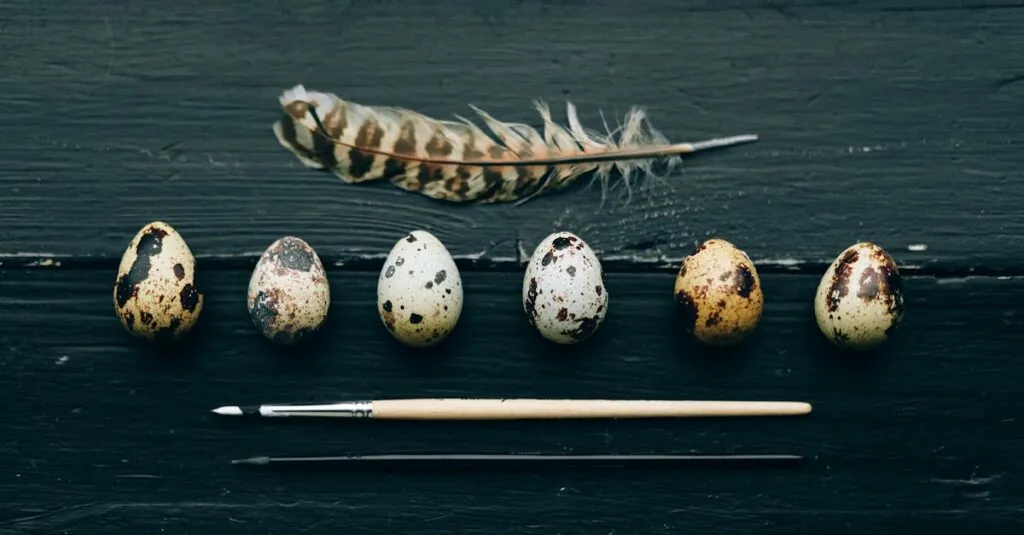Table of Contents
ToggleWhen it comes to keeping preschoolers engaged, flower crafts are a blooming good idea! These colorful projects not only spark creativity but also transform little hands into tiny artists. Picture this: giggles echoing as kids glue petals and paint stems, all while learning about nature. It’s like a mini garden party right at the crafting table!
Parents and educators alike know that flower crafts can be a delightful way to teach colors, shapes, and fine motor skills. Plus, who doesn’t love a little mess? With just a few supplies, kids can create masterpieces that could rival any gallery—well, maybe not quite, but they’ll sure have fun trying! Dive into the world of flower crafts and watch those little imaginations blossom.
Overview of Flower Crafts for Preschoolers
Flower crafts for preschoolers offer a vibrant way to explore creativity and nature. Engaging in these activities allows children to express themselves through colors and shapes. Parents and educators find that these crafts help develop essential skills, particularly fine motor skills, as little hands cut, glue, and paint.
Preschoolers often enjoy making flower collages using materials like colored paper, tissue paper, and recycled items. This hands-on approach encourages exploration while introducing concepts related to environmental awareness. By creating flower art, children learn to recognize different types of flowers and their features.
Another popular activity involves painting flower pots. Kids can decorate pots with bright colors and patterns, fostering their artistic expression. Planting flowers in these pots nurtures a sense of responsibility, as children care for their blooming creations.
Crafting flower-themed greeting cards provides additional opportunities for expression. Children can personalize cards for family members using their handmade flowers, enhancing social skills through sharing. Craft sessions often become joyful, messy experiences where cooperation takes center stage.
Understanding the significance of flowers enhances children’s learning, encouraging conversations about seasons and growth. As preschoolers engage in flower crafts, they gain a deeper appreciation for nature’s beauty. Overall, these projects offer endless possibilities for creativity, ensuring that every child’s artistic journey flourishes.
Benefits of Flower Crafts
Flower crafts provide numerous developmental benefits for preschoolers. Engaging with these projects aids in honing fine motor skills essential for tasks like writing and self-care. Grasping scissors, gluing petals, and manipulating various materials enhances hand-eye coordination. Additionally, children learn to differentiate textures and colors through their creative processes. These skills contribute to overall cognitive development and physical dexterity.
Developmental Skills
Fine motor skills flourish through flower crafts. Cutting, gluing, and assembling flowers requires precision and practice, promoting hand strength. Children gain confidence as they accomplish each step, fostering independence. Engaging in such projects sharpens concentration and encourages them to follow directions. Social skills also develop as they collaborate with peers, sharing ideas and materials. This interaction builds communication skills essential for their growth.
Creativity and Imagination
Creativity thrives in the world of flower crafts. Preschoolers unleash their imaginations by experimenting with colors and designs. Creating unique flower arrangements offers them a platform for self-expression. They explore different artistic techniques, such as painting and collage-making. Each project becomes an opportunity for storytelling, where they represent their feelings or themes through art. Working with diverse materials encourages innovative thinking, allowing their artistic visions to blossom fully.
Popular Flower Craft Ideas
Engaging in flower crafts offers preschoolers numerous creative opportunities. These activities not only foster fun but also teach valuable skills.
Paper Flower Making
Paper flower making brings joy and creativity to young artists. Children can cut different shapes from colorful paper while enhancing their fine motor skills. Using scissors encourages precision and control. Gluing petals together helps with hand-eye coordination and spatial awareness. Creating flower arrangements cultivates an understanding of design and balance. Simple instructions and templates allow kids to explore various styles. This craft promotes individuality as each child creates unique blooms. Lastly, paper flowers can beautify homes and classrooms, offering a sense of accomplishment.
Painting with Flowers
Painting with flowers introduces a unique way for preschoolers to express themselves. This activity uses real flowers to create beautiful prints. Children can dip flower heads in non-toxic paint and stamp them onto paper. Each print captures the flower’s natural shape, creating stunning artwork. Through this process, kids learn about colors and patterns. They also gain insights into nature as they observe the flowers’ textures and forms. Painting with flowers not only inspires creativity but also ignites curiosity. Encouraging children to discuss their artwork enhances language skills and boosts confidence.
Nature Flower Collages
Nature flower collages immerse preschoolers in the wonders of the outdoors. Collecting real flowers and leaves fosters an appreciation for nature. Children can arrange these natural materials on a sturdy surface to create unique designs. This process nurtures creativity and allows for experimenting with colors and textures. As kids collaborate, they practice sharing materials and ideas. Discussions regarding the types of flowers and their characteristics enhance knowledge about biodiversity. Such projects also spark conversations about seasons and habitats, deepening connections to the environment. Nature flower collages become meaningful keepsakes that celebrate a child’s artistic journey.
Tips for Successful Flower Craft Sessions
Craft sessions thrive when planned with intention. Using the right materials and creating a comfortable environment encourages creativity and engagement.
Materials to Use
Select child-friendly items like construction paper, liquid glue, and non-toxic paints. Incorporate natural elements such as leaves and petals for texture. Gather scissors and markers designed for small hands, promoting independence. Recycled materials, like bottle caps or old magazines, foster environmental awareness. Assemble a variety of colors to inspire imaginative designs.
Creating a Comfortable Environment
Ensure the crafting space is well-lit and spacious, allowing preschoolers to move freely. Set up a designated table with easy access to materials. Providing aprons or old shirts prevents messes from overwhelming enthusiasm. Create an inviting atmosphere through soft background music, enhancing focus. Arrange comfortable seating to support sustained engagement, making it easier for kids to immerse themselves in their creative projects.
Safety Considerations
Safety plays a crucial role in flower crafts for preschoolers. Always supervise children during crafting activities to prevent accidents. Opt for child-safe scissors when cutting materials. Liquid glue should come from containers designed with child-proof caps. Non-toxic paints ensure safety and fun in creative projects.
Creating a safe workspace is important. Clear the area of any hazardous items or small objects that could pose choking hazards. Use a large table or floor space for ample crafting room. Providing cover for surfaces with newspapers or craft mats protects against messes while keeping the space tidy.
During activities that may involve sharp tools or small components, explain the importance of being gentle. Establish rules for sharing materials to minimize disputes among young artists. Encouraging children to communicate their needs fosters a sense of cooperation while crafting.
Keep an eye on allergies. Some children may have reactions to specific materials or flower types. Always ask parents about allergies before starting an activity that includes natural elements. Encourage washing hands after handling materials to maintain cleanliness and safety.
Children should wear old clothes or use aprons to protect their outfits from paint and glue spills. Caution should especially be taken with fabrics that are difficult to clean. A clear overview of the crafting timeline can help maintain pace and focus throughout the session.
First-aid supplies should be readily available in case of minor injuries. Having band-aids and antiseptic wipes on hand provides peace of mind. Implementing these simple safety considerations ensures a positive and enjoyable flower crafting experience for preschoolers.
Flower crafts provide preschoolers with a vibrant avenue for creativity and learning. These projects not only enhance fine motor skills but also nurture a love for nature and art. By engaging in various activities, children develop essential cognitive and social skills while expressing their unique personalities.
Parents and educators can foster an enriching environment that encourages exploration through flower crafts. With careful planning and a focus on safety, these creative sessions can become memorable experiences. Embracing the beauty of flowers in crafts allows young learners to blossom artistically and emotionally, setting the foundation for a lifetime of creativity and appreciation for the natural world.







